
35 mm film is a film gauge used in filmmaking, and the film standard. In motion pictures that record on film, 35 mm is the most commonly used gauge. The name of the gauge is not a direct measurement, and refers to the nominal width of the 35 mm format photographic film, which consists of strips 1.377 ± 0.001 inches (34.976 ± 0.025 mm) wide. The standard image exposure length on 35 mm for movies is four perforations per frame along both edges, which results in 16 frames per foot of film.
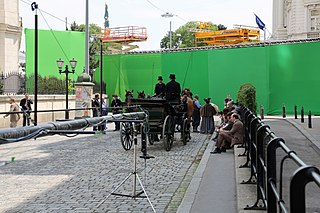
Special effects are illusions or visual tricks used in the theatre, film, television, video game, and simulator industries to simulate the imagined events in a story or virtual world.
IMAX is a proprietary system of high-resolution cameras, film formats, film projectors, and theaters known for having very large screens with a tall aspect ratio and steep stadium seating.
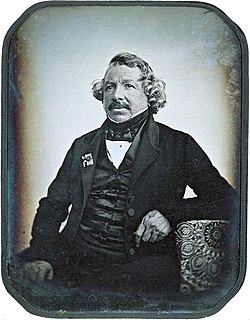
Louis-Jacques-Mandé Daguerre, better known as Louis Daguerre, was a French artist and photographer, recognized for his invention of the daguerreotype process of photography. He became known as one of the fathers of photography. Though he is most famous for his contributions to photography, he was also an accomplished painter and a developer of the diorama theatre.

A movie palace is any of the large, elaborately decorated movie theaters built between the 1910s and the 1940s. The late 1920s saw the peak of the movie palace, with hundreds opened every year between 1925 and 1930. With the advent of television, movie attendance dropped and many movie palaces were razed or converted into multiple screen venues or performing arts centers.

A xenon arc lamp is a highly specialized type of gas discharge lamp, an electric light that produces light by passing electricity through ionized xenon gas at high pressure. It produces a bright white light that closely mimics natural sunlight, with applications in movie projectors in theaters, in searchlights, and for specialized uses in industry and research to simulate sunlight, often for product testing.

The Stanley Theater at Kennedy Boulevard and Pavonia Avenue is near Journal Square in Jersey City, New Jersey.

The Movietone sound system is an optical sound-on-film method of recording sound for motion pictures that guarantees synchronization between sound and picture. It achieves this by recording the sound as a variable-density optical track on the same strip of film that records the pictures. The initial version was capable of a frequency response of 8500 Hz. Although sound films today use variable-area tracks, any modern motion picture theater can play a Movietone film without modification to the projector. Movietone was one of four motion picture sound systems under development in the U.S. during the 1920s, the others being DeForest Phonofilm, Warner Brothers' Vitaphone, and RCA Photophone, though Phonofilm was primarily an early version of Movietone.
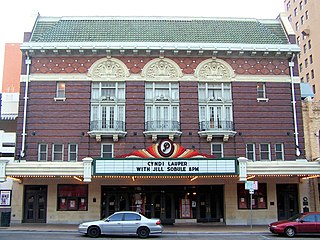
The Paramount Theatre is a live theatre venue/movie theatre located in downtown Austin, Texas. The classical revival style structure was built in 1915. The building was listed in the National Register of Historic Places on June 23, 1976.

The Capitol Theatre is a heritage-listed theatre located at 3-15 Campbell Street, Haymarket, in the Sydney central business district, Australia. It was designed by Henry White and John Eberson and built from 1893 to 1928. The property was added to the New South Wales State Heritage Register on 2 April 1999. The former circus venue, atmospheric theatre and market venue in owned by Capitol Theatre Management Pty Limited, a wholly owned subsidiary of Foundation Theatres Pty Limited. Foundation Theatres owns the Sydney Lyric and Capitol Theatre.

The Olympia Theater is a theater located in Miami, Florida. Designed by John Eberson in his famed atmospheric style, the theater opened in 1926. Throughout its history, the venue has served as a movie theater, concert venue and performing arts center. In 1984, it received historical designation by the NRHP. The Olympia Theater and its sister venue, the Tampa Theatre are the only remaining atmospheric theaters in Florida.
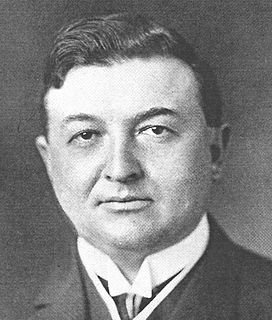
John Adolph Emil Eberson was a European born American architect best known for the development and promotion of movie palace designs in the atmospheric theatre style.

An atmospheric theatre is a type of movie palace design which was popular in the late 1920s. Atmospheric theatres were designed and decorated to evoke the feeling of a particular time and place for patrons, through the use of projectors, architectural elements and ornamentation that evoked a sense of being outdoors. This was intended to make the patron a more active participant in the setting.

The Majestic Theatre is San Antonio's oldest and largest atmospheric theatre. The theatre seats 2,264 people and was designed by architect John Eberson, for Karl Hoblitzelle's Interstate Theatres in 1929.

Richmond CenterStage is a performing arts center in Richmond, Virginia that includes the Altria Theater and the theater formerly known as the Carpenter Theatre Center for the Performing Arts. The Carpenter Theatre was originally a Loew's Theatre movie palace developed by the Loew's Theatres company and designed by John Eberson. Construction of the building began in 1927 and its doors were opened in 1928. The Altria Theater was constructed a year before in 1926 and was originally a Shriners hall.

The Manufacture de films pour cinématographes, often known as the Star Film Company, was a French film production company run by the illusionist and film director Georges Méliès.
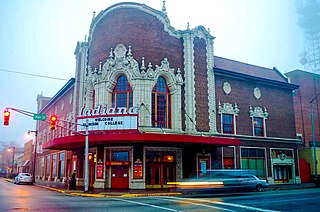
The Indiana Theatre is a historic theater in Terre Haute, Indiana. It was added to the National Register of Historic Places on November 13, 1997 and is located in the Wabash Avenue-East Historic District. It opened on January 28, 1922. The theatre was built by Terre Haute resident T. W. Barhydt and was designed by John Eberson. Eberson, who later developed the atmospheric theater style of movie palace, first experimented with atmospheric design elements at the theatre. Eberson stated, "Into this Indiana Theatre I have put my very best efforts and endeavors in the art of designing a modern theatre such as I have often pictured as what I would do were I given a free hand." Through this quote Eberson suggests that the Indiana Theatre embodies the raw beginning of his experiment with a "dream" theater that marked the beginning shift to his atmospheric style.

The Marion Palace Theatre is a movie palace constructed in 1928 in Marion, Ohio, United States for the Young Amusement Company. It is listed on the National Register of Historic Places because of its significance to the atmospheric theatre architectural style popular in the United States during the 1920s.

The State Theatre also known as the Kalamazoo State Theatre in Kalamazoo, Michigan was designed by renowned architect John Eberson and built by founder Colonel William Butterfield in 1927. The Kalamazoo State is one of the very few remaining atmospheric picture palaces still intact. It currently remains in operation today as the main performance hall for musicians, comedian, and other live entertainment in the Kalamazoo area.
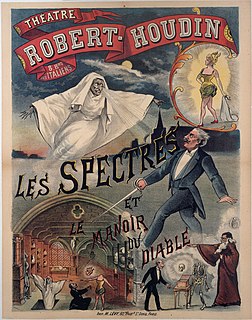
The Théâtre Robert-Houdin, initially advertised as the Théâtre des Soirées Fantastiques de Robert-Houdin, was a Paris theatre dedicated primarily to the performance of stage illusions. Founded by the famous magician Jean-Eugène Robert-Houdin in 1845 at No. 164 Galerie Valois as part of the Palais-Royal, it moved in 1852 to a permanent home at No. 8, Boulevard des Italiens. The theatre's later directors, before its demolition in 1924, included Robert-Houdin's protegé Hamilton and the illusionist and film innovator Georges Méliès.



















